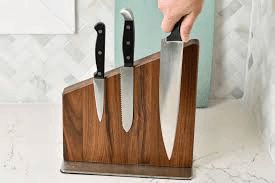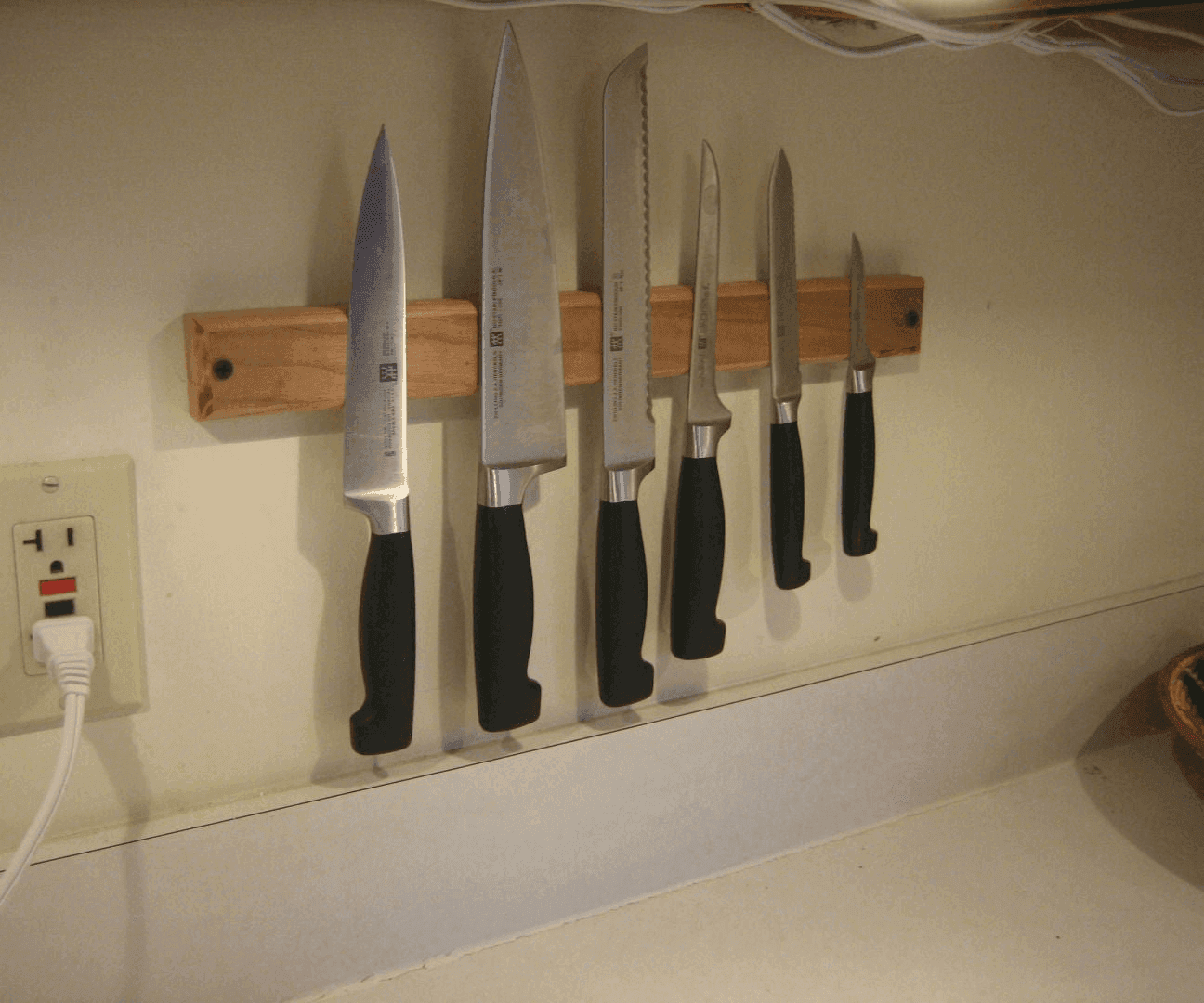Introduction
Imagine transforming a simple kitchen necessity into a statement piece that combines sleek design with supreme functionality. Magnetic knife holders not only offer a visually appealing way to store your knives but also keep them easily accessible and sharp. The secret to their effectiveness lies in the choice of magnets. Selecting the right magnets not only enhances the holder’s strength but also ensures durability and safety. This article dives into the best magnets for the job and provides a detailed guide on crafting your very own magnetic knife holder.
What are the top magnets used in making magnetic knife holders?
The most popular magnets used in magnetic knife holders are Neodymium and Ceramic magnets. Neodymium magnets, made from an alloy of neodymium, iron, and boron (NdFeB), are the strongest type of permanent magnets available commercially. Their high coercivity and magnetic strength make them ideal for securely holding knives in place, even larger or heavier types. On the other hand, Ceramic magnets, also known as ferrite magnets, offer a more cost-effective solution. While they are less powerful than their Neodymium counterparts, they provide sufficient hold for lighter knives and are more resistant to corrosion.
Understanding Magnetic Knife Holders

A magnetic knife holder is a simple yet ingenious solution for keeping your kitchen knives organized and within easy reach. These holders utilize the power of magnets to securely hold your blades, allowing you to free up valuable counter or drawer space. Beyond their practical benefits, magnetic knife holders can also serve as a stylish focal point, complementing the overall aesthetic of your kitchen.
The primary advantages of using a magnetic knife holder include:
– Efficient storage: Knives are neatly displayed and easily accessible, reducing clutter on your countertops.
– Improved safety: Knives are securely held in place, minimizing the risk of accidental cuts or injuries.
– Enhanced organization: Magnetic holders allow you to arrange your knives in a visually appealing manner.
– Versatility: Magnetic holders can be mounted on walls, backsplashes, or even the inside of cabinet doors, providing flexible storage options.
Types of Magnets Used in Knife Holders
When it comes to magnetic knife holders, two primary types of magnets stand out as the most commonly used: Neodymium (NdFeB) and Ceramic (ferrite) magnets.
Neodymium Magnets
Neodymium magnets, also known as NdFeB magnets, are the most powerful permanent magnets available on the market. These magnets are composed of a rare-earth alloy of neodymium, iron, and boron, which gives them exceptional magnetic strength.
The key advantages of using Neodymium magnets in knife holders include:
– Exceptional holding power: Neodymium magnets can securely hold even the heaviest of knives, ensuring a stable and reliable storage solution.
– Compact size: Their high magnetic strength allows for a smaller magnet size, enabling more discreet and space-efficient knife holders.
– Durability: Neodymium magnets are resistant to demagnetization, maintaining their magnetic properties over time.
However, Neodymium magnets do have some drawbacks:
– Higher cost: These magnets are generally more expensive than their ceramic counterparts.
– Potential for corrosion: Neodymium magnets can be susceptible to corrosion, especially in humid environments, requiring proper coating or protection.
Ceramic Magnets
Ceramic magnets, also known as ferrite magnets, are a more affordable alternative to Neodymium magnets. These magnets are composed of ceramic materials, typically a mixture of iron oxide and barium or strontium carbonate.
The key advantages of using Ceramic magnets in knife holders include:
– Cost-effectiveness: Ceramic magnets are generally less expensive than Neodymium magnets, making them a more budget-friendly option.
– Corrosion resistance: Ceramic magnets are highly resistant to corrosion, making them suitable for use in damp or humid environments.
– Ease of handling: Ceramic magnets are less brittle and easier to work with compared to Neodymium magnets.
While Ceramic magnets may not be as powerful as Neodymium magnets, they can still provide sufficient holding strength for most kitchen knives.
Materials and Tools Needed for DIY Magnetic Knife Holder
To create your own magnetic knife holder, you’ll need the following materials and tools:
Materials:
– Wooden board or plank (e.g., oak, maple, or walnut)
– Magnetic strips or individual magnets (Neodymium or Ceramic)
– Adhesive (e.g., epoxy, super glue, or hot glue)
– Finishing materials (e.g., stain, varnish, or oil)
Tools:
– Saw (hand saw, jigsaw, or power saw)
– Drill and drill bits
– Sandpaper (various grits)
– Measuring tape or ruler
– Pencil or marker
– Clamps (optional)
Step-by-Step Guide to Making a Magnetic Knife Holder
Step 1: Planning and Design
Begin by determining the size and shape of your magnetic knife holder. Consider the number of knives you need to accommodate, the available space in your kitchen, and the overall aesthetic you want to achieve. Sketch out your design and plan the placement of the magnets.
Step 2: Preparing the Base Material
Measure and cut the wooden board or plank to your desired size and shape. Use a saw to ensure clean, straight edges. Sand the surface of the wood to create a smooth finish, progressing from coarse to fine grit sandpaper.
Step 3: Placing and Fixing the Magnets
Arrange the magnets on the wooden surface according to your design plan. Ensure that the magnets are evenly spaced and positioned to provide optimal support for your knives. Apply a generous amount of adhesive (such as epoxy or super glue) to the back of each magnet and firmly press them into place. Allow the adhesive to fully cure before proceeding.
Step 4: Assembling and Finishing Touches
If desired, add any additional features or embellishments to your magnetic knife holder, such as hooks or shelves. Sand the entire surface again to ensure a smooth finish. Apply your chosen finishing material, such as stain, varnish, or oil, to protect the wood and enhance its appearance.
Safety and Maintenance Tips
When working with strong magnets, it’s essential to take the necessary safety precautions. Keep magnets away from electronic devices, credit cards, and other sensitive items that could be affected by the magnetic field. Avoid placing your fingers between the magnets, as they can pinch or trap your skin.
To maintain the magnetic strength and cleanliness of your knife holder, regularly wipe it down with a damp cloth. Avoid exposing the magnets to moisture or harsh chemicals, as this can lead to corrosion and a loss of magnetic power over time.
Customization Ideas
The beauty of creating your own magnetic knife holder lies in the opportunity to personalize it to suit your unique style and needs. Experiment with different wood types, shapes, and sizes to find the perfect fit for your kitchen. You can also incorporate additional features, such as hooks for hanging utensils or shelves for storing other kitchen essentials.
Conclusion
Magnetic knife holders are a practical and stylish addition to any modern kitchen. By understanding the key differences between Neodymium and Ceramic magnets, you can choose the right option to create a durable and visually appealing storage solution. With the step-by-step guide provided, you can now confidently embark on your own DIY magnetic knife holder project, unleashing your creativity and transforming your kitchen into a harmonious blend of function and design.


